Sir Henry de la Beche
James Gay Sawkins
Lucas Barrett
Mr Nicholas
Duran
R Whitfield
R. T. Hill
Charles Taylor Trechmann
Alfred Matley
Verner Zans
Lawrence Chubb
Lucas Barrett, F.G.S., F.L.S.
Early Life
Lucas Barrett was born in London on the 14th of November, 1837. He was the eldest son of the iron-founder Mr George Barrett, who designed the iron work in Kings Cross Railway Station in London.
Lucas was schooled at Royston, near Cambridge, in the county of Hertfordshire. Following this, he attended University College School in London.
During his holidays, he spent his time rambling around in woods and fields in search of shells, fossils, insects, and plants; these he would carry to the British Museum to have identified and this is how he developed his interest in natural history.
In 1853 he went to Ebersdorf, near Lobenstein, Voigtland, in Germany, where he stayed for a year and studied chemistry and botany. While in Ebersdorf he made collections of minerals and plants from the Hartz (the highest mountain range in northern Germany), and also made a pedestrian tour of Bavaria, which only cost him one shilling a day!
The British Museum
On returning to England, natural history became his sole study, and shortly afterwards an engagement was obtained in that department of the British Museum. Here he worked chiefly on the Crustaceans, arranging the Cirripedes (Barnacles).
The Letter from Professor Sedgwick
At the age of 18 years, Lucas Barrett paid a visit to Prof Adam Sedgwick of the Woodwardian Museum in Cambridge, which the Professor subsequently remarked upon, in a letter: Soon after Professor McCoy, on obtaining a scientific appointment at Melbourne, had left this University, Mr Barrett called on me; he had the look of a sprightly intelligent boy; and I was so captivated by his knowledge, skill, and youthful zeal, that, without hesitation, and with much joy, I secured his services, not as an Academic officer (for no office was vacant), but as my friend, assistant, and fellow-workman in the Museum. Right manfully, and with much skill, he went on with the arrangement of our cabinets, refusing no labour, but delighting in it. Nor was this labour small; for very large additions were made to our collections by purchase, and treasures were poured into it almost daily by zealous members of the University and by other friends. But he was never confined to the mere drudgery of arrangement. Not merely with my consent, but with my encouragement, he devoted himself to elaborate studies of those parts of palaeontology to which he had not previously attended.
The Youngest Fellow of the Geological Society
On the 2nd of May 1855 Lucas Barrett was elected a fellow of the Geological Society.
Norway and Finland (1855)
In the summer (June and July) of 1855, he accompanied Mr MacAndrew through the northern seas to North Cape on a dredging expedition to Norway and Finland. One important object of this voyage was to discover the effect of the Gulf Stream on Northern forms of life. The results were published in The Annals and Magazine of Natural History for October 1856 which was translated into French and German.
Greenland (1856)
In 1856 he obtained leave of absence, and accompanied Mr J. W. Tayler to Greenland.
Providentially delayed at Copenhagen, he missed the first trader, which foundered at Sea. It was the seal-hunting season when he arrived, and no one, native or European, could be induced to assist him, till the temptation of sugar and coffee procured the help of eight strong Esquimaux women, who, with great courage and skill, rowed him about for two months among the floating ice, in an open boat. During all this time dredging was carried on actively; and not only did he effect his purpose, and discover that lines of distribution of life drawn through the sea would, like the isothermal lines, have to bulge up and he carried far to the north on the European side; but, with a view to determining what relation in that region the life in the sea would bear to that preserved in the deposit it was helping to form, he dredged up the sea bottom. Sketches and observations, too, were made among the Greenland glaciers, and on one of these occasions he nearly lost his life. Returning to Cambridge, the treasures gathered were stored in the Woodwardian Museum, of which he may be said to have almost created and named the natural history portion.
Vigo, north-west Spain (1857)
In 1857, he again accompanied Mr MacAndrew in a voyage to Vigo (the last cruise of the 'Naiad'), and added extensively to his collection of Echinodermata. Still, nothing was published except a short communication (by himself and Mr Woodward), in the Proceedings of the Zoological Society, on the genera Synapta and Cheirodota.
The Cambridge Greensand
In Cambridge he started looking at the local geology. He was the first discoverer of the bones of birds in the Cambridge Greensand and also discovered many fossil reptiles. For the Plesiosaurus, he showed that the atlas and axis are sometimes anchylosed and sometimes free — a point previously in dispute. He also discovered Pterodactyls in the Cambridge Greensand and produced a geological map of the county near Cambridge.
The Jamaican Survey
The West Indian Geological Survey was set up by the Colonial Office in London in 1857. First to be surveyed would be Trinidad, and George Parks Wall was selected as Director, his assistant would be James Gay Sawkins who was working in the copper mines of Jamaica.
But following the survey of Trinidad, which ended in 1859, G. P. Wall resigned and a new director had to be found.
Sir Roderick Murchison refused to nominate anyone because he felt that the surveyors in Trinidad had not received sufficient remuneration.
So Sir H. Bulwer, of the Colonial Office, approached Professor John Phillips at Oxford, and he recommended Lucas Barrett for the position.
Leaving for Jamaica
Lucas Barrett wrote to Sir Edward Bulwer-Lytton on the 5th of March 1859 asking for passage by the mail [packet] which leaves Southampton on the 17th of March to Jamaica to take up his position, and he also requested “the sum of £150 be paid in advance in account of my annual salary (half of that part of my salary that is paid by the Home Government) in order to purchase maps, charts and instruments which will be required for the Geological Survey of Jamaica.
In reply Sir Edward Bulwer-Lytton stated that instruments had already been sent and that Mr Barrett should provide a list of the maps and charts that should be sent.
Mr Sawkins and Mr Barrett
James Sawkins had packed up the scientific instruments used in the geological survey of Trinidad and he and his wife had also packed up their personal possessions. They boarded the mail steamer at Port-of-Spain and also arrived in St. Thomas on the 1st of April. It was in St. Thomas where James Sawkins and Lucas Barrett met for the first time, and immediately James Sawkins learned, with surprise, that he was not to receive any increase in pay or personal allowance. At hearing this, he decided that his only option at not receiving some additional remuneration for his services was to resign, and he informed Lucas Barrett accordingly.
Mr and Mrs Sawkins and Mr and Mrs Barrett arrived in Kingston, Jamaica, on the 5th of April, 1859. James Sawkins immediately arranged a meeting with the Governor to explain his financial situation.
On the 6th April, 1859, James Sawkins wrote to the Secretary of State for the Colonies, stating that his remuneration was insufficient to meet his personal and travelling expenses and stating his intention to resign if it was not increased.
On the 9th April, 1859, Lucas Barrett wrote to Sir E. B. Lytton noting what a great loss it would be not only to the Survey but particularly to the mining interests of this island if he [Sawkins] were to take that step, and recommended that the part of Sawkins' salary paid by the Home Government should be increased by thirty-five pounds per annum and that his allowance, paid from the Colony should be increased to one pound per day.
Both Sawkins and Barrett also wrote to Sir Roderick Murchison about the remuneration issue.
After discussion, Sawkins allowance was raised to one pound per diem, and he did not resign from the survey.
St Thomas in the East
Lucas Barrett and James Sawkins starting their geological survey at the east end of the island (St Thomas in the East). Their travel was by horse and they carried with them their servants. There were no inns, and so overnight accommodation would need to be arranged with the Jamaican Planters on their sugar estates and plantations.
The geological surveyors gathered many exciting observations in St. Thomas in the East. In the Plantain River, some three miles above the Bath Spa, they found a limestone containing fossils of hippurites (rudists), inoceramus and nerineae and Lucas Barrett from his knowledge of European faunas new immediately that these rocks were of Cretaceous age. They found a similar limestone resting on trap rocks on the Cold Ridge of the Blue Mountains at an altitude of 2500 feet. De la Beche had originally classed these rocks as belonging to the Coal Measures or Transition Series, but had subsequently withdrawn that opinion which was based solely on their mineralogical character in the absence of any fossils.
Next, the survey moved to Portland, with Lucas Barrett mapping the area to the west of the Rio Grande, and James Sawkins mapping the area to the east.
On the 5th of April, 1860, Lucas Barrett was elected a Fellow of the Linnean Society (London).
Trinity College and the Great Exhibition
Lucas Barrett returned to England in 1862 as one of the Commissioners from Jamaica to the Great Exhibition, receiving half pay as he was away from his post in Jamaica. The Great Exhibition was a wonderful spectacle, and all kinds of minerals (including copper and manganese ores) from Jamaica were put on display together with the completed maps from the eastern part of the island. The display was awarded two medals.
In October of 1862, he acted as one of the Secretaries of the Geological Section at the Meeting of the British Association at Cambridge, and attained the kindly opinion of all who then first formed his acquaintance, as he had already done of those who had previously become intimate with him. The association went on an excursion to Hunstanton to look at the Carstone, the Red Rock and the White Chalk.
Now Lucas Barrett asked for full pay rather than half pay as he had worked for Jamaica at the Great Exhibition, but this was rejected by Sir R. Murchison. He also asked for an extension of his time in England which was rejected as well.
Back to Jamaica
There still remained for Mr Barrett the region of the coral-reefs, which could not be explored with the dredge, and there he expected to find the living representatives of the fossils described by Mr Moore and Dr Duncan.
Lucas Barrett returned to Jamaica in November of 1862. During his absence, the collony had instigated a committee to look at the geological work of the surveyors and they asked Mr Barrett to give evidence on the 18th of December.
He carried back to Jamaica a diving-apparatus to enable him personally to explore the reefs. Having once gone down safely and successfully in shallow water, he would not wait for the assistance of his friends; and set out on the 19th of December, attended by a crew and servants, to the coral-reefs outside Port Royal. At some distance from the land he descended into deep water, provided with 100 feet of air-tubing, and holding the "life-line" only in his hand; and after the lapse of more than half an hour he floated to the surface, but no longer alive.
Lucas Barrett was buried at St Andrew Parish Church and there is a plaque on the wall commemorating his service to Jamaica.
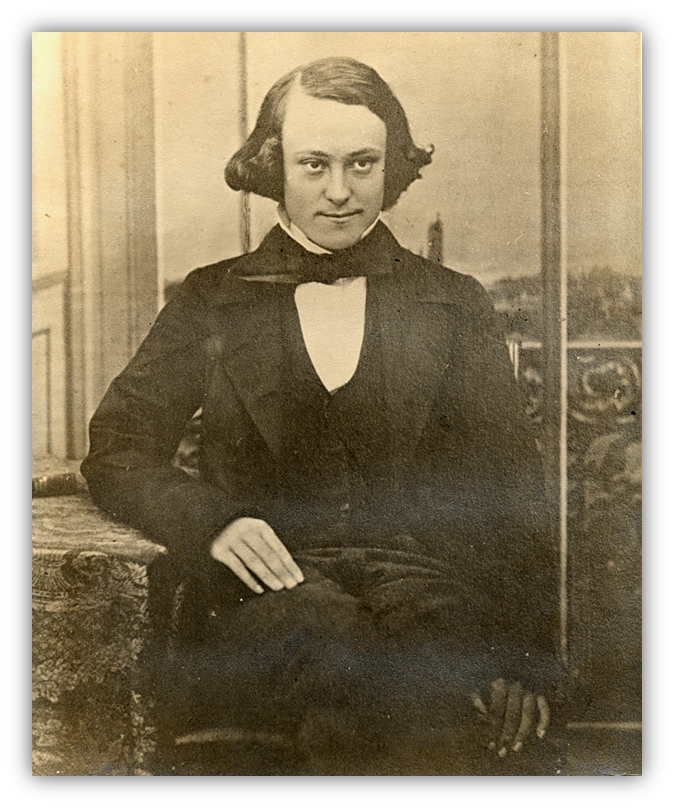
Lucas
Barrett from a photograph at the Mines and Geology Division
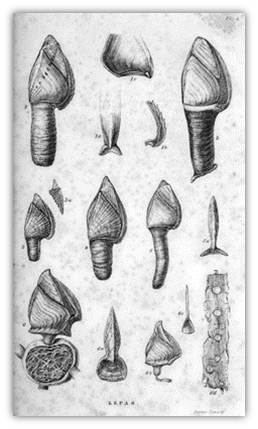
One of Charles
Darwin's illustrations of Cirrepedes from "A monograph on the sub-class
Cirripedia", published in 1851 - Lucas Barrett would have been aware of this volume
in his work at the British Museum in 1853.
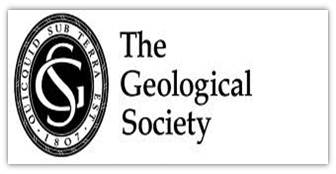
On
the second of May, 1855, Lucas Barrett was elected a Fellow of the Geological Society.
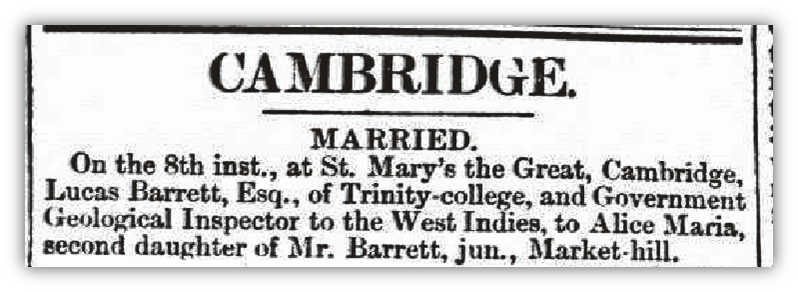
Details of his
marriage in the Bury and Norwich Post Tuesday 15 March 1859.
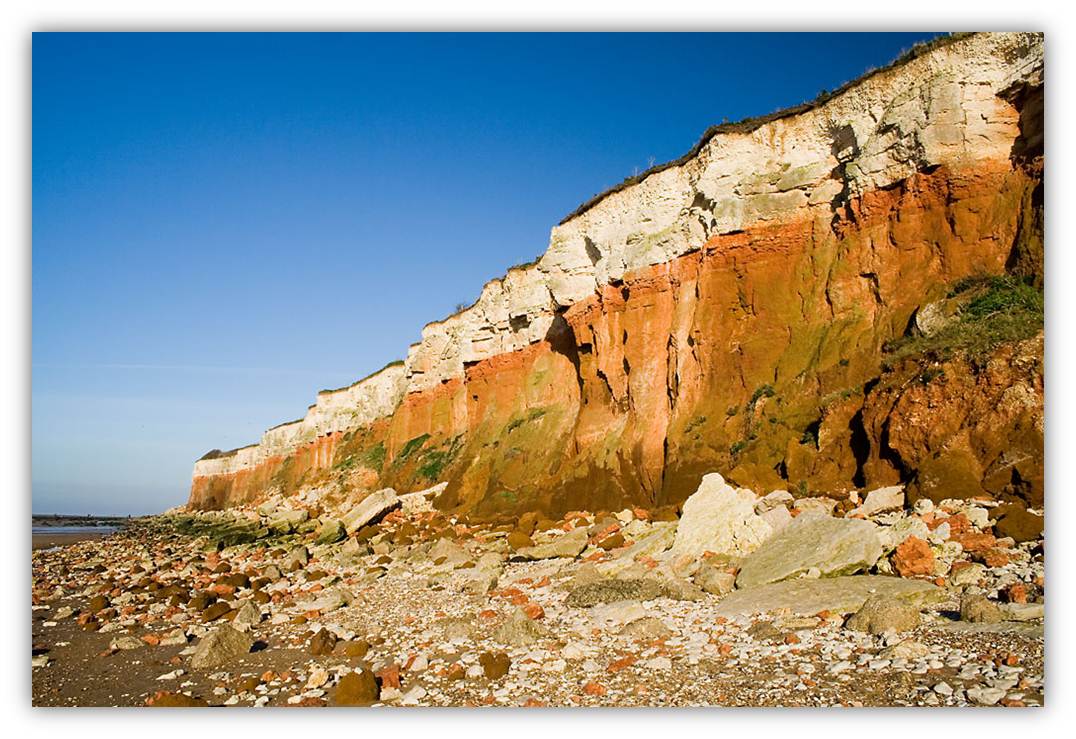
The
Carstone, Red Chalk and Lower Chalk at Hunstanton, where Lucas Barrett led a memmorable
trip for the British Association in 1862. Photograph ©Andrew Dunn, 18 February 2006, available
in wiki commons.
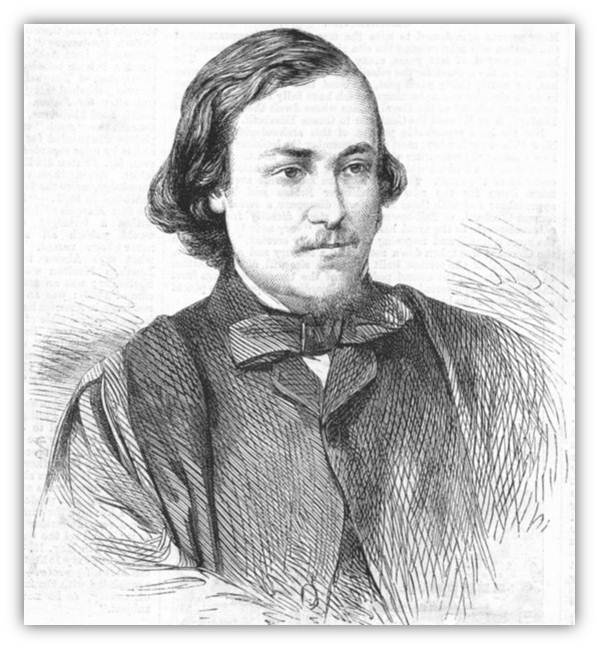
Lucas
Barrett from a sketch in the Illustrated London News